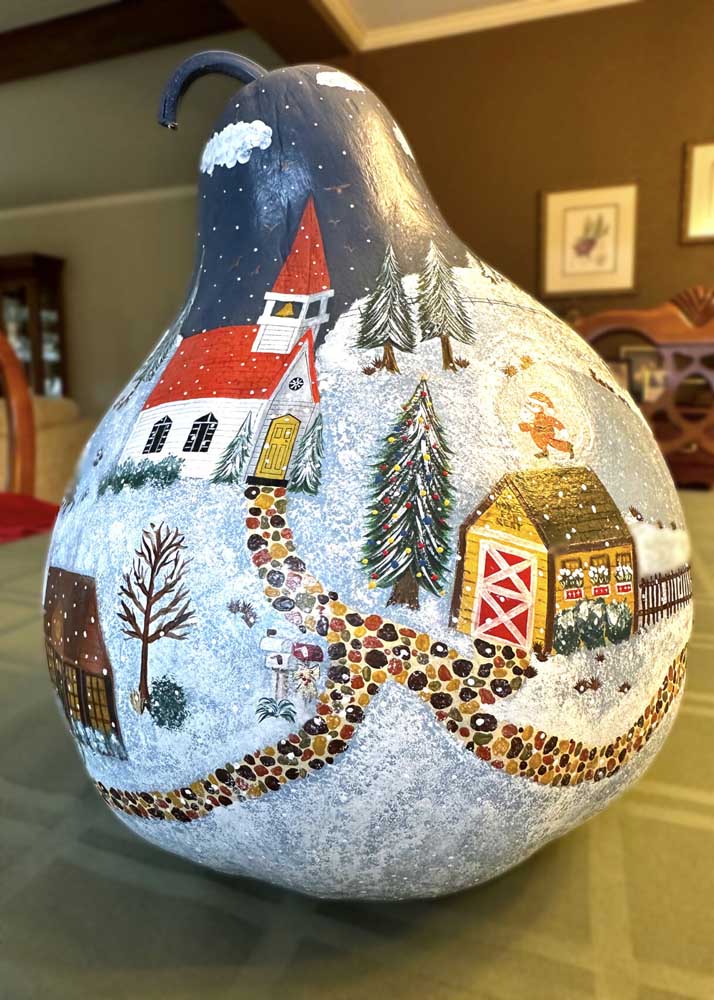Sperry: Plant’s leaves plagued with brown spots
Published 12:00 am Sunday, January 22, 2023

- A painted gourd by Neil Sperry.
Dear Neil: I have a Silver Queen aglaonema that has been around for 30 years. It’s almost a member of the family. I’ve been cutting off sprigs and giving them to our children for years. Now the mother plant is developing spots on its leaves. I’ve repotted it into fresh potting soil and I pay close attention to its water needs. It grows well for a while, but then the new growth develops the spots. Please let me know what I might do to help it.
Answer: I might just as well have written this very letter. My Silver Queen is 25 years old in my home office. Watching it seven days a week I have observed that the spotted leaves are always on the old stems. The new growth coming up from the soil is much healthier and more vigorous. In fact, when I trim off the dried leaves just pulling gently on them has often caused the old stems to come up out of the pot without much in the way of roots. They’ve lost all their vigor. I’ve removed a few more of the weak stems and started fertilizing a bit more often and my Silver Queen as well as another taller aglaonema I have growing beside it have really responded positively. I doubt that your plant has any kind of fungal leaf spot. It’s more likely just a plant that has a few stems that are running out of steam.
Trending
Dear Neil: Was this past fall’s heavy acorn crop due to the serious drought or just a random occurrence?
Answer: Nut-producing trees are noted for being “alternate bearing.” They will have a heavy crop one year and a very light crop the next, swinging back and forth like a pendulum. Pecans are famous for it, but as you have noted, oaks act the same way. The production of acorns had already been determined before the drought set in last summer. Dry conditions affected more the size of the individual acorns and whether the trees were able to hold them to full maturity. I’ve noticed on the oaks and pecans at our house, even individual trees will be on different cycles. Some will have heavy years one year while their neighbors are bearing nothing.
Dear Neil: We have enjoyed having Wheeler’s dwarf pittosporums around a water feature for the past 12 years. They did very well until two years ago. One of the plants was attacked by mealy bugs at that time. I tried several insecticides and finally was able to get some relief with Neem oil. Was that the best control? We have had a subsequent outbreak and would like to save the remaining plants. (Is my identification of mealy bugs correct?)
Answer: I believe your identification if correct, although it’s unusual for them to be active in any way during the winter outdoors. They are a soft-bodied scale insect, so oil sprays are one good remedy. You could also use the systemic insecticide Imidacloprid applied as a drench around the plants. Do not allow it to get into the water if you have fish. Mealy bugs are not common problems with pittosporums, although I have seen them. Cold damage is a much bigger issue. You didn’t mention where these plants are growing (which part of Texas and the amount of protection in their specific setting), but if they have been exposed to the extreme cold of February 2021 and December 2022 that could have weakened them as well.
Dear Neil: I bought a very old gourd in an estate sale last fall. It is 54 inches around at the widest. I can hear seeds rattling around inside it. I’d like to get them out without ruining the gourd. How can I do that, and do you think they would still sprout?
Answer: I don’t know what you intend to do with the gourd, but gourd workers and painters have special saws and other tools for working with gourds. (I paint Santas and other Christmas items, so I’m very familiar with these people and their tools.) If the gourd has been kept dry all the while the seeds might still be viable. However, if you simply want to grow very large gourds, there are plenty of seed sources available online for rare, odd-shaped and very large gourds. Just 10 minutes on the Internet will find you plenty.
Trending
Dear Neil: It seems like I’ve been watering my shrubs and perennials for months and months now. I was hoping winter would be a rest, but it’s been so warm and dry recently. Do I need to continue watering?
Answer: Probably, yes. My answer is always to feel the soil. It will be your guide. If it’s dry to the touch, soak it deeply, then wait until it’s dry before you soak it again. Yes, I can imagine that you’ll need to water every 7 to 10 days during weather like much of Texas has encountered over the past couple of months.
Dear Neil: I have lost one Arizona cypress to Seiridium canker. We really like the look of this evergreen. We have six more and we worry about the day when we might have to replace them all. What is a plant that would give us the same look without having that disease?
Answer: I am totally with you. First, we lost Leyland cypress to that awful disease. Then, about 10 years ago, Italian cypress trees started to go down. More recently, Arizona cypress. Of them all, the Arizona cypresses were the prettiest. Sadly, many of the upright junipers have their own disease issues that keep me from recommending them. Eastern redcedar, the native juniper of the eastern half of Texas, is probably the best replacement, but it doesn’t look much like Arizona cypress. I wish I had a better answer but there just isn’t one out there.






